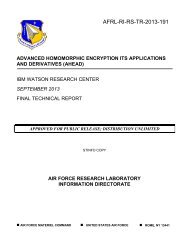EN100-web
EN100-web
EN100-web
You also want an ePaper? Increase the reach of your titles
YUMPU automatically turns print PDFs into web optimized ePapers that Google loves.
Special theme: Scientific Data Sharing and Re-use<br />
toward Automatic Data Curation<br />
for Open Data<br />
by Thilo Stadelmann, Mark Cieliebak and Kurt Stockinger<br />
In recent years large amounts of data have been made publicly available: literally thousands of<br />
open data sources exist, with genome data, temperature measurements, stock market prices,<br />
population and income statistics etc. However, accessing and combining data from different data<br />
sources is both non-trivial and very time consuming. These tasks typically take up to 80% of the<br />
time of data scientists. Automatic integration and curation of open data can facilitate this process.<br />
Most open data has scientific or governmental<br />
origins and much of it resides in<br />
isolated data stores. In data warehousing,<br />
data integration as a discipline provides<br />
best practices concerning data preparation<br />
and data management tasks by<br />
offering standardized processes and tool<br />
chains. However, with the recent popularity<br />
of Big Data, an unprecedented<br />
number of new data sources contribute to<br />
an increasingly heterogeneous trove of<br />
data. Hence, ‘data curation’ – a fully<br />
automated means of intelligently finding<br />
and combining possible data sources in<br />
the unified space of internal and open<br />
data sources – is in high demand [1].<br />
We recently finished a market research<br />
and architectural blueprint, funded by<br />
the Hasler Stiftung, to evaluate requirements<br />
and business cases concerning<br />
the development of such an automatic<br />
data curation system in Switzerland.<br />
Market Research<br />
The Swiss ICT sector is healthy and<br />
innovative, sustained by strong players<br />
in research (e.g., universities and privately<br />
held research institutions) and<br />
industry (e.g., finance and pharma) as<br />
well as a large ecosystem of SMEs and<br />
startups. All surveyed parties among<br />
this group of stakeholders responded by<br />
stating their need for better data curation<br />
support of open data that has not<br />
been previously integrated within<br />
internal data sources.<br />
As examples, we identified several use<br />
cases that rely on the existence of such a<br />
service:<br />
• Economic research would be significantly<br />
improved by using automatic<br />
data curation for unifying tax and rent<br />
data of Swiss municipalities<br />
• In a transportation research project,<br />
the overall project cost increased by<br />
25% because of scattered and heterogeneous<br />
public data.<br />
• Scientific digital media archives<br />
could fully index their work, thereby<br />
creating new research and application<br />
possibilities.<br />
For these reasons, national funding<br />
agencies are very keen to support the<br />
development of such a service based on<br />
a solid model of business and operations.<br />
Such a business model could consist of<br />
offering automatic data curation as software-as-a-service<br />
for open data. In<br />
order to comply with open data standards,<br />
the access to the data itself has to<br />
be free, while additional services could<br />
be offered on a freemium basis. To be of<br />
interest to industrial customers, private<br />
installations to curate confidential<br />
internal data could also be offered.<br />
Figure 1: Example of<br />
automatically integrating four<br />
different data sources for socioeconomic<br />
research.<br />
32<br />
ERCIM NEWS 100 January 2015



